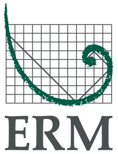Data background
To measure our social, economic and environmental impacts and support programs for improving our sustainability performance, ERM collects and reports data relevant to our global operations. The data are grouped, where applicable, in alignment with the focus areas presented in this report.
More information on the location of specific GRI and UN Global Compact content within this report can be found in the Indexes section.
Organizational boundaries
ERM follows the GRI Standards, including the identification of material topics. All information in this report, including data and performance information presented, covers ERM's operations as a group. Data reported are for those entities controlled by ERM Worldwide Group Limited (EWGL), which is based in London, UK.
Data in this report are inclusive for ERM CVS. ERM CVS is a wholly owned subsidiary of EWGL. ERM CVS works with many of the world's leading multinational organizations and delivers independent, third-party, performance-driving certification, verification and report assurance services to help clients improve their sustainability performance. For more details of these services, visit the ERM CVS site.
ERM CVS operates under ERM's internal policies and procedures, and the following sections of this Sustainability Report 2019 therefore apply also to ERM CVS unless indicated otherwise: Our people, Health and safety, Society, Environment, and Governance. Because ERM and ERM CVS have combined human resource systems and office premises, the data in this report include the operations of ERM CVS.
Due to the nature of its work, ERM CVS has additional policies and procedures relating to independence and an Advisory Board that undertakes the role of the Committee for Safeguarding Impartiality.
Methodologies
Our ERM Sustainability Reporting Protocol guides the data-collection process. Where applicable, the protocol is based upon external guidance, including the GRI Standards and the World Resources Institute/WBCSD Greenhouse Gas Protocol.
Taking advantage of the professional expertise of our workforce and our purpose as an organization, ERM created a Sustainability Network of coordinators, advisors, leaders and champions across all of our offices and regions. Members of the network focus on enhancing our sustainability program and improving our performance in support of the SDGs. The Sustainability Network coordinates the collection of the majority of our environmental data. We expect to continue to improve the robustness and depth of our data over time.
We report environmental data for offices that fall within ERM's material threshold (as defined in our Sustainability Reporting Protocol) per fiscal year (FY), which runs 1 April to 31 March. ERM's Sustainability Reporting Protocol provides guidance for the development and maintenance of robust data collection systems that will measure sustainability performance across all key performance areas in a consistent, accurate and auditable manner.
We continue to improve our greenhouse gas data, including working with landlords to increase access to actual energy consumption data for leased offices. Where data are unavailable, we estimate consumption based on the amount of space we lease and expected energy intensity of office buildings.
On a per-indicator basis, sources constituting less than 1 percent of ERM's total impact for that performance indicator annually were excluded from the data collection and reporting process. Sources excluded are reviewed annually to determine if emissions are relevant for a continued de minimis exemption. For FY19, leased or owned office locations that were registered as encompassing fewer than 50 square meters, excluding dedicated server hosting spaces, were also considered de minimis and excluded from the data collection and reporting process. Impacts associated with office spaces of this size are projected to be less than 1 percent of ERM's total impact in aggregate. Travel data for employees residing in these offices are included in the office responsible for booking travel.
For data normalized by the number of FTE employees, we applied the average yearly FTE, which is more representative of FTEs throughout the year than the year-end FTE. Average yearly FTEs have been applied in ERM Sustainability Reports since FY15.
All financial data are reported in US dollars, unless otherwise noted.
Data for new offices or offices added through ERM acquisitions during the reporting period are included where available from the date of opening or acquisition – subject to specific transition arrangements to ERM systems and processes. These arrangements are noted where relevant. In some instances in the data presented, rounding results in small discrepancies.
